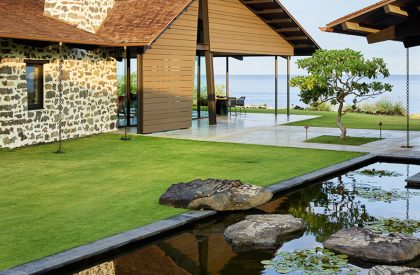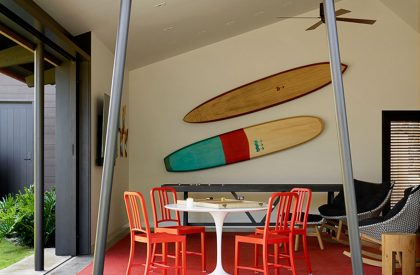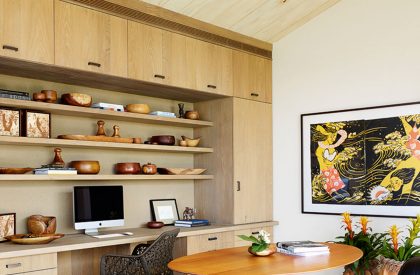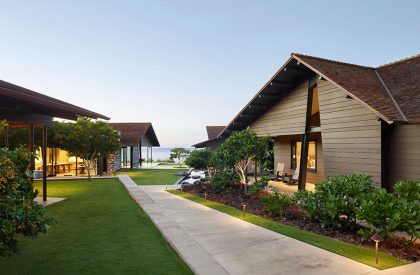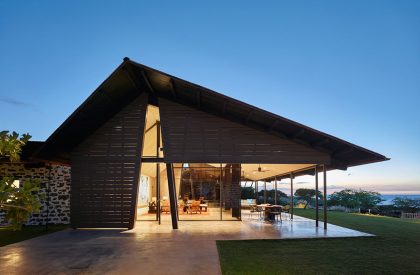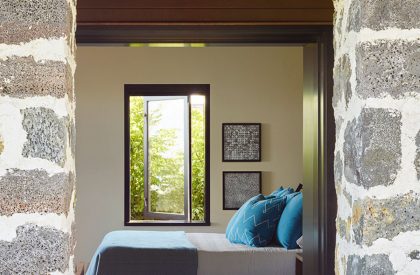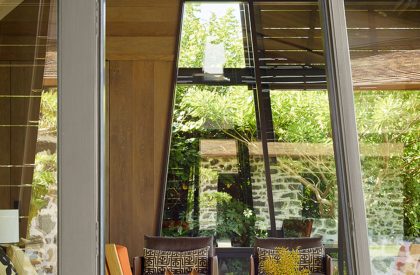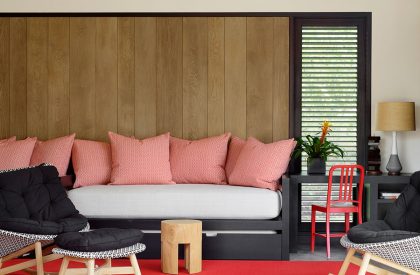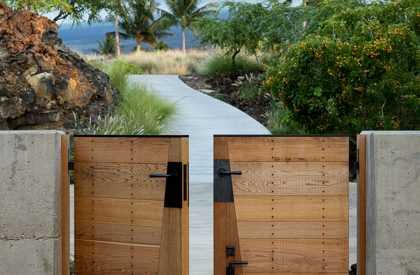Excerpt: Makani’ Eka by Walker Warner Architects is an example of modern architecture and interiors that rely on traditional materials and touchstones. The site plan and architectural style were influenced by the loosely clustered traditional Hawaiian villages. The design, which consists of canted steel columns, steeply pitched roofs, and rhomboidal window and door openings, is a modern take on the early Hawaiian hale shelters.
Project Description

[Text as submitted by architect] Set atop a hardened lava flow with views of sky, sun, and water, this family compound strikes a balance between modernity and tradition. Old and new ebb and flow through a simple composition of small structures linked by a lush courtyard and a series of walkways and patios. Composed of four independent structures, including a cedar-clad main living pod, the siting balances the desire to host friends and family as well as privacy.


Architecture and interiors are modern yet rely heavily on traditional materials and touchstones. “We think of it as a village,” notes Greg Warner, of the arrangement, a grouping of four separate structures. The home is built to rest gently in the landscape but also to last for generations. “We execute enduring architecture—in the sense of material quality but also livability,” Warner says. “We have high hopes for the legacy of this project.”


Traditional Hawaiian villages, typically organized in loose clusters, inspired both 1.5-acre site plan and the architectural style. The composition of canted steel columns, steep-pitched roofs, and rhomboidal window and door openings “represent a contemporary interpretation of early Hawaiian hale shelters,” Warner says. “They’re like modernist lean-tos.” The compound is surrounded by a field of lava and native grasses.



The main living pod is pushed to the edge of the sea, while the supporting structures, containing the two guest suites and communal relaxation areas, are set back, deeper in the property. Guest suite bedrooms open onto concrete-walled private courts for additional seclusion.
The arrangement assumes that the three-bedroom residence feels expansive and takes advantage of the views. Interiors encompass approximately 4,800 square feet, but the arrangement makes the three-bedroom residence feel expansive.


The use of heavily mortared lava rock was inspired by the historic Mokuaikaua Church, located in nearby Kailua. Windows are framed in stained sapele mahogany. Western red cedar serves as the dominant wood—both for cladding and the roof shingles—since it resists heat, moisture, and insects. Inside, stained and lightly polished concrete flooring keeps things cool during the day.
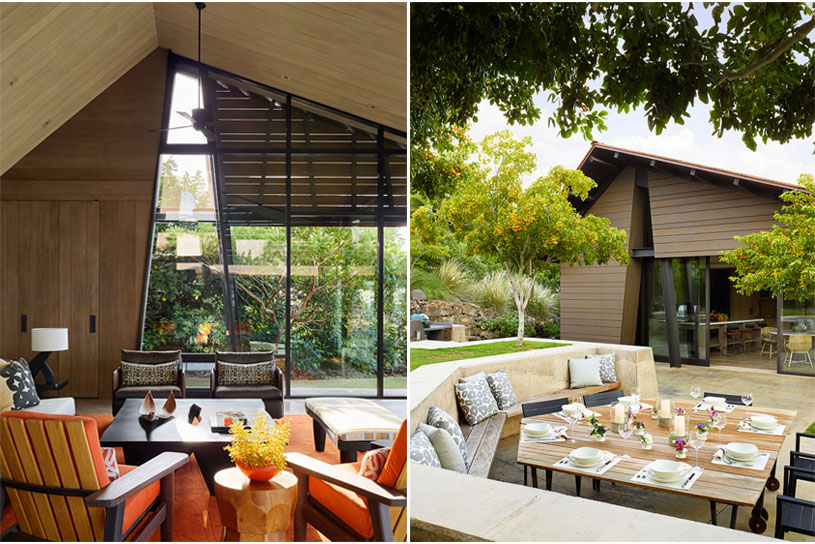
Inside spaces flow seamlessly to outside. Sapele-framed sliders glide open to the elements, and operable windows swivel to coax in the breeze and encourage cross ventilation. “The living room unfurls to become porch-like,” Warner adds, noting the continuity of floor and ceiling materials between interiors and adjacent alfresco spaces.

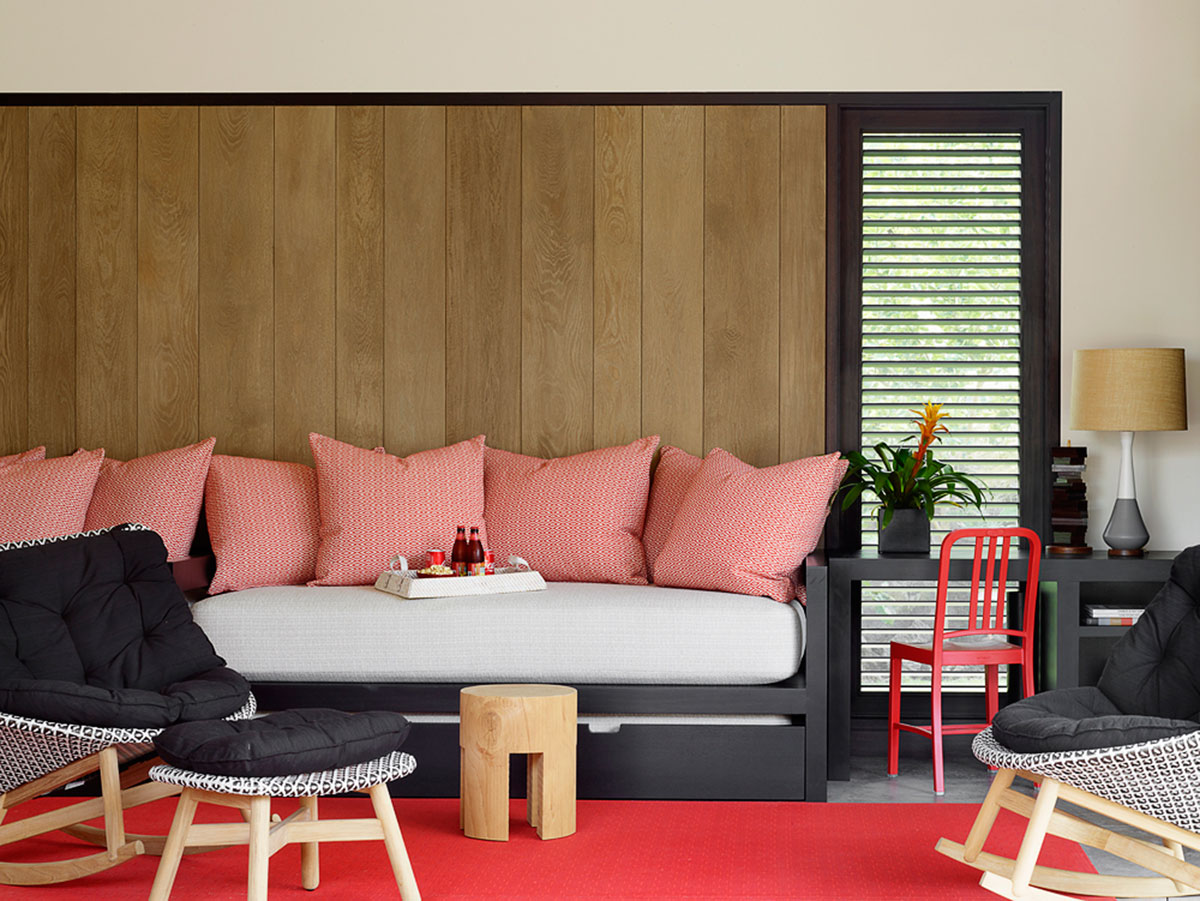
The degree of openness led Marion Philpotts-Miller of Philpotts Interiors to favor “indestructible” solution-dyed acrylic upholstery for much of the casual furniture. A Lee Kelly oil on canvas animates the living room’s assemblage of Christian Liaigre furnishings, including an oak lamp and sofa and wenge lounge chairs; the ceiling slats are bleached Douglas fir.
The kitchen’s island and table are topped in honed Cararra marble. Custom surfboards—one hand-painted, the other crafted of paulownia—hang above the rec room’s Eero Saarinen table.


Philpotts-Miller sought to capture the “adventurous nature” of the clients. “The use of color is very playful and dynamic,” she says. In the rec room, for instance, custom surfboards are mounted on the wall like artworks. A koi pond is the focal point of the courtyard between the main living and master suite pods.
The scheme is no-frills, simple, and airy, with a midcentury vibe that Philpotts-Miller explains was inspired by the work of Hawaiian modernist Vladimir Ossipoff. “Because the architecture is so thoughtfully put together and there’s so much natural texture, we didn’t need to load up the interiors,” Philpotts-Miller continues.

The master bedroom is likewise grounded with earthy, timber-toned accents—whitewashed wood wall paneling, a walnut bench—and also lifted via a sky-blue rug and throw pillows.


The master bedroom’s bench is walnut. Concrete walls and cedar slats enclose the custom cast-concrete tub standing in the courtyard off the master bathroom. Flooring in the master bathroom and throughout is polished, stained concrete. A niche in the master bedroom features a chair by Naoto Fukasawa. The master suite’s study culminates in a sitting area with a Charles and Ray Eames lounger offering Maui views.


